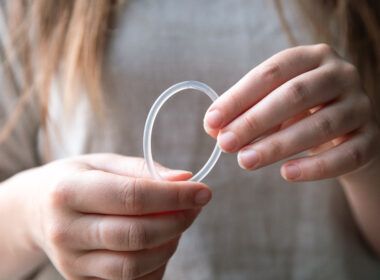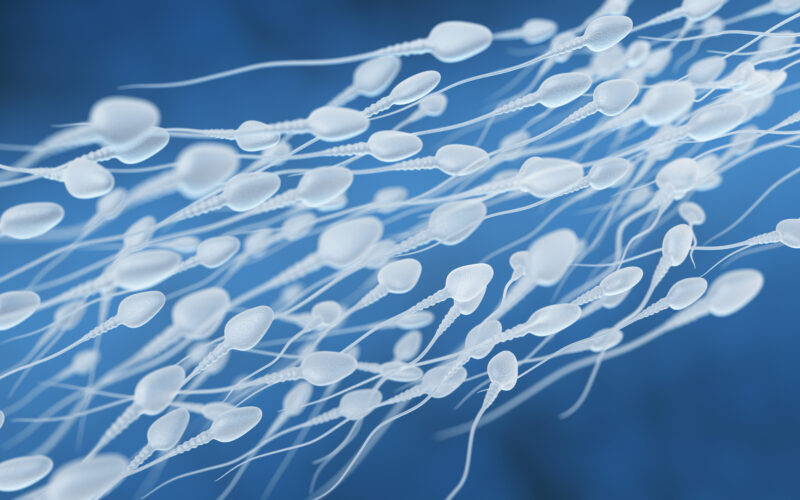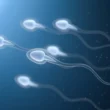Sperm counts in human males have been dropping worldwide for years, but how big a problem is that? In a 2021 GQ artículo, epidemiologist Shanna Swan discussed a 2017 meta-analysis she co-authored that studied trends in the sperm counts of nearly 43,000 men in order to answer this question. The analysis found that the average sperm count per milliliter of semen had dropped over 50% since 1973. Because “[s]perm counts are really low in many places in the world,” Swan believes, “people should be very concerned.” In her book Count Down: How Our Modern World is Threatening Sperm Counts, Altering Male and Female Development, and Imperiling the Future of the Human Race, she called falling sperm counts “a global existential crisis.” In the GQ interview, Swan further explained how various chemicals and toxins in our man-made environment (such as phthalates) negatively impact fertility in both men and women. In men, exposure to certain chemicals can decrease testosterone production, and thereby decrease sperm count.
A skeptic’s response to the “male fertility crisis”
In stark contrast to Swan’s doomsday-report, a 2021 analysis of her study in El New York Times asserted that decreased sperm counts do not automatically translate to decreased fertility, and claimed that falling global sperm counts are no cause for concern. Science journalist Rachel E. Gross implied that fertility concerns were overblown, and expressed frustration with men “wax[ing] poetic on the contents of their testes.” Because Swan’s study excluded women, Gross opined that it failed to contextualize the real-world impact of low sperm counts in the bigger picture of a couple’s overall fertility since “focusing only on the male leaves out key interactions between sperm, the female reproductive tract, and the egg.”
Whether or not the decline in sperm counts qualifies as a global health crisis is a debate which journalists, scientists, and policymakers will hash out as they continue to analyze the data, although many scientists do seem to think this is a legitimate cause for global concern [1]. One real-world indicator of just how impactful decreased sperm counts are for men’s fertility is the percentage of cases when male factors play a role in a couple’s infertility. How often might male infertility be the primary reason a couple can’t conceive?
How often does male infertility play a role in a couple’s inability to conceive?
Historically, exploration of male factors was often overlooked when couples struggled with infertility. Traditionally, women have shouldered the burden of infertility testing and diagnosis (if not outright blame), and the ensuing treatments to correct any issues. But the reality is that at least 40% of infertile cases are estimated to be due to male infertility, and algunos researchers estimate that number is even higher. Both men’s y women’s fertility health, then, should be safeguarded and studied to increase and sustain a couple’s natural fertility [2].
Let’s review what we mean by male “infertility,” along with its symptoms and root causes. In a separate article [LINK], we’ll cover treatment options, paying special attention to those that may be more natural and less invasive than surgery or other invasive medical procedures.
How is male infertility defined?
Male infertility is defined by Stanford Health as “a disease of the reproductive system that impairs the body’s ability to perform the basic function of reproduction.” In men, reproductive function is analyzed by reproductive physiologists in terms of the quality and quantity of the sperm.
Sperm quality
Quality of the sperm has to do with both morphology (shape) and motility (forward movement). Shape-wise, sperm should have an oval head and a long tail. Although it is not uncommon to have a high number of misshapen sperm in a typical sample, morphological defects can affect the ability of the sperm to penetrate the egg. DNA is also included in sperm quality analysis, and certain supplements and nutrients can improve DNA integrity in sperm [3].
Sperm motility refers to sperm’s ability to “go the distance,” traveling from the testicles to the penis and, after sex, through the woman’s vagina, cervix, and uterus to a Fallopian tube for fertilization. This 2022 scientific review of male reproductive physiology and factors affecting male fertility noted, “among all the semen parameters, sperm motility is considered to be a strong predictive marker of male fertility potential” [4]. The role of sperm motility is so significant that it’s been shown to be predictive of successful conception y live birth rates in IVF procedures [5].
Sperm quantity
Quantity refers to the number of sperm per milliliter of semen. Normal count ranges from 60-120 million sperm per milliliter. This seems like a lot of sperm, and in fact, it’s a higher number than we might intuitively think, given that only one sperm is needed to fertilize an egg. This is perhaps why the author of El New York Times article mentioned above took such offense at the idea of a male fertility “crisis,” even as average sperm counts decline worldwide. However, we know that our bodies are designed very specifically, and there is a reason why men ejaculate millions of sperm in one go. Marilyn M. Shannon, in her book Fertilidad, ciclos y nutrición explains this well:
When the sperm count drops ‘only’ to 15-20 million per milliliter, the man is usually [functionally] infertile. These numbers seem to be necessary to overcome the acidic environment of the vagina, to compensate for loss as sperm migrate through the female reproductive tract, and to provide for adequate numbers if ovulation occurs two or three days after intercourse. Dozens of sperm must arrive in the vicinity of the ovum to chemically digest its covering before the nucleus of a single sperm can fuse to the nucleus of the ovum, the event that begins the life of a new individual.1
So there you have it: Quite a bit of sperm can still be present in a man’s semen, even if it’s not “enough” to make him functionally infertile; the sperm count has to be high enough to combat all of the complex, complicated factors that go into the process of conceiving a child. After all, many natural functions have to be operating normally in both the man’s and the woman’s body for conception to be possible. A man’s body naturally compensates for this phenomenon by sending as much sperm as possible into each ejaculation; hence, a decrease in sperm count may be a real cause for concern–especially on a societal level.
Other factors that can impact male fertility
Various causes ranging from hormone imbalance (such as low testosterone) to sexually transmitted infections (STIs) to enlarged testicular veins (known as varicocele) can impact both the formation and the number of sperm produced by the testicles. Sometimes the sperm can be “blocked” from moving where they need to go, either because seminal fluid is too thick or because of natural blockages in the vas deferens (or even a complete lack of the vas deferens altogether, which can happen to men with cystic fibrosis), or because of erectile dysfunction. Prior surgeries, medications, chromosome defects, and tumors (both malignant and benign) can also affect fertility.
Lifestyle impacts on male fertility
During her GQ interview mentioned above, epidemiologist Shanna Swan discussed the role endocrine disruptors can play in male fertility. More research is needed to confirm the extent to which endocrine disruptors impact fertility, but este estudio acknowledges that endocrine disrupting chemicals (EDCs) “interfere with the production, release, transport, metabolism, binding, or elimination of natural hormones in the body,” which in turn can impact the reproductive system [6]. EDCs are found in pesticides, herbicides, plastics, and pharmaceuticals, to name just a few sources of these seemingly ubiquitous chemicals, and thus it is likely that most people encounter EDCs throughout their lifetime. In fact, some data suggests that EDCs and other chemicals can affect the reproductive development of babies in the womb [7].
Obesity is another lifestyle factor impacting male fertility. Although more research needs to be done to examine the relationship between obesity and a couple’s infertility, higher BMI correlates with lower sperm count [8]. Obesity can also increase sperm DNA damage (read: sperm quality damage) and is associated with low sperm count (oligozoospermia) and no sperm (azoospermia) [9][10]. Other lifestyle choices that can affect fertility are excessive exercise, which can increase oxidative stress and thus damage the sperm and the sperm DNA, overheating of the groin area (from a sedentary lifestyle, for example, or for men in certain occupations such as firefighters and welders), some medicamentosy smoking [11][4][12].
Lo esencial
It’s possible that both those researchers sounding the alarm about low sperm counts, as well as those pooh-poohing them as mere sensationalism, are missing the bigger picture. Certainly, there are logical reasons that low sperm counts could have real-life impacts on male fertility, and consequently, a couple’s combined fertility. But sperm counts, or quantity, are one facet of the bigger picture of male fertility factors, alongside sperm quality and sperm motility.
Fortunately, hope for positive improvement is within our grasp.The significant role lifestyle factors appear to play in sperm health is actually a good thing, because this means something can likely be done about it. In este artículo, I cover what that “something” or “some things” could be.
Referencias:
[1] Levine H, et al. “Male reproductive health statement (XIIIth international symposium on Spermatology, may 9th-12th 2018, Stockholm, Sweden.” Basic Clin Androl. vol. 28 (2018):13. doi: 10.1186/s12610-018-0077-z. PMID: 30397480; PMCID: PMC6205799. [2] Schlegel, P N. “Evaluation of male infertility.” Minerva ginecologica vol. 61,4 (2009): 261-83. [3] Song, Gyun Jee et al. “Relationship between seminal ascorbic acid and sperm DNA integrity in infertile men.” International journal of andrology vol. 29,6 (2006): 569-75. doi:10.1111/j.1365-2605.2006.00700.x [4] Dcunha R, et al. “Current Insights and Latest Updates in Sperm Motility and Associated Applications in Assisted Reproduction.” Reprod Sci. vol.29, no. (2022) :pp. 7-25. doi: 10.1007/s43032-020-00408-y. Epub 2020 Dec 7. PMID: 33289064; PMCID: PMC7721202. [5] Villani MT, et al. “Are sperm parameters able to predict the success of assisted reproductive technology? A retrospective analysis of over 22,000 assisted reproductive technology cycles.” Andrology vol. 10, no. 2 (2022):pp. 310-21. doi: 10.1111/andr.13123. Epub 2021 Nov 12. PMID: 34723422; PMCID: PMC9298690. [6] Jeng HA. “Exposure to endocrine disrupting chemicals and male reproductive health.” Frente Salud Pública, vol.5, no. 2 (2014): 55. doi: 10.3389/fpubh.2014.00055. PMID: 24926476; PMCID: PMC4046332. [7] Marques-Pinto A, Carvalho D. “Human infertility: are endocrine disruptors to blame?” Endocr Connect, vol. 17, no. 2(2013):R15-29. doi: 10.1530/EC-13-0036. PMID: 23985363; PMCID: PMC3845732. [8] Sallmén, Markku et al. “Reduced fertility among overweight and obese men.” Epidemiology (Cambridge, Mass.) vol. 17,5 (2006): pp. 520-3. doi:10.1097/01.ede.0000229953.76862.e5 [9] Dupont C, et al. “Obesity leads to higher risk of sperm DNA damage in infertile patients.” Asian J Androl vol. 15, no. 5 (2013):pp. 622-5. doi: 10.1038/aja.2013.65. Epub 2013 Jun 24. PMID: 23792341; PMCID: PMC3881654. [10] Sermondade, N et al. “BMI in relation to sperm count: an updated systematic review and collaborative meta-analysis.” Human reproduction update vol. 19,3 (2013): pp. 221-31. doi:10.1093/humupd/dms050 [11] Tremellen, Kelton. “Oxidative stress and male infertility–a clinical perspective.” Human reproduction update vol. 14,3 (2008): pp. 243-58. doi:10.1093/humupd/dmn004 [12] Kovac, Jason R et al. “The effects of cigarette smoking on male fertility.” Postgraduate medicine vol. 127,3 (2015): pp. 338-41. doi:10.1080/00325481.2015.1015928Lecturas complementarias:
How FAM can help a couple with male infertility to conceive
Why we really need better options for treating male infertility
The affordable, effective alternative to IVF no one talks about











